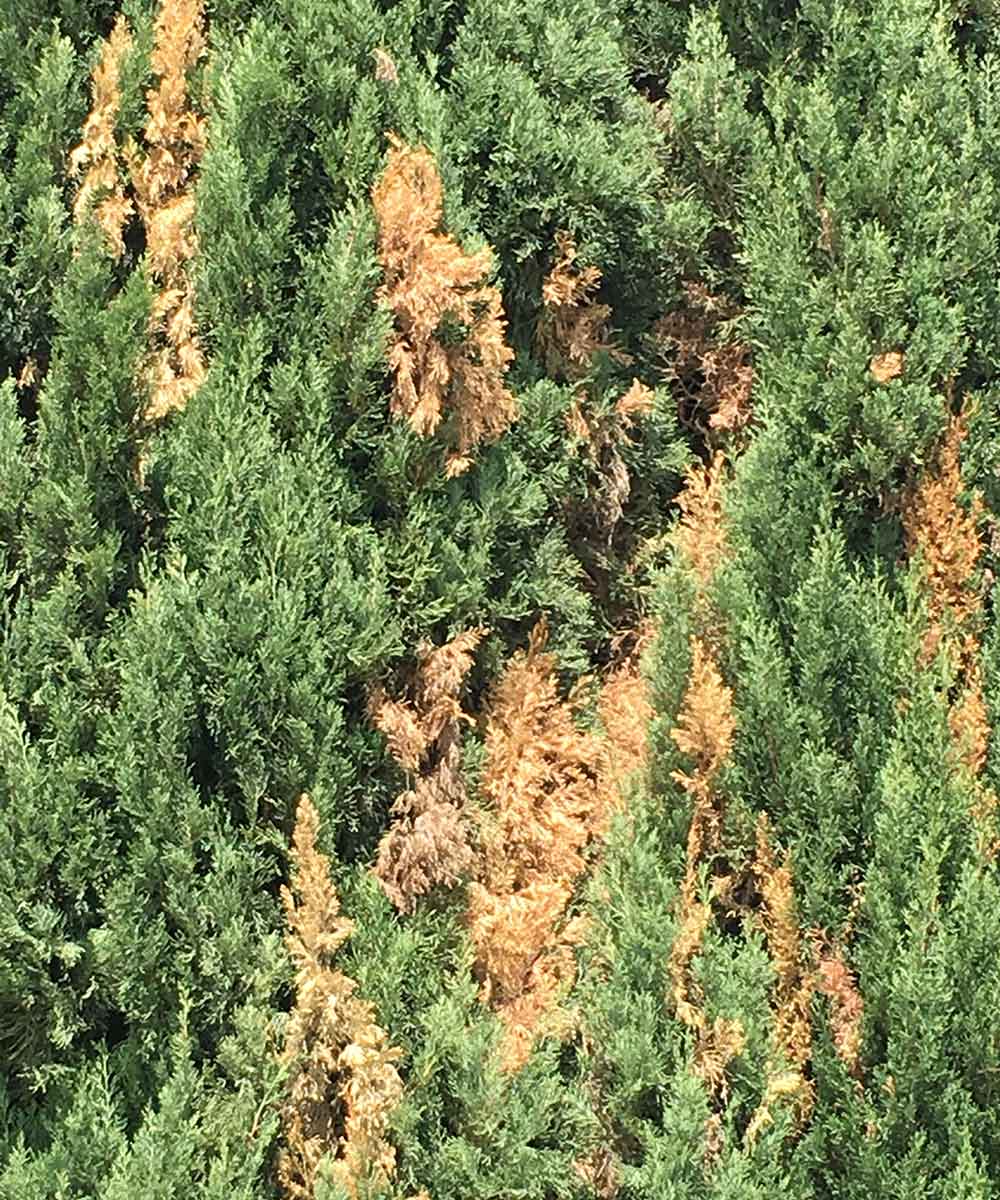What is going on with the Italian Cypress trees around Dallas? A question we have been asking ourselves and hearing from homeowners all over Dallas & Ft. Worth in the last year. You can see it almost anytime you venture out around Dallas. Beautiful, mature Italian Cypress trees that have been used to accent and enhance landscapes and architecture across the metroplex are turning brown, their foliage is thinning and they are looking terrible. What is the problem?
The Culprit: Environmental Factors + Seridium Canker
In talking with arborists and other landscape professionals, we have learned the primary culprit infecting the Italian Cypress is a disease called Seridian Canker. This canker disease has been rapidly spreading around town with the help of the climate and environmental conditions like drought conditions, high humidity and dramatic temperature swings (like this last winter) which are normal for the Dallas and North Texas area. These temperature swings and drought conditions have really stressed these trees and made them vulnerable to disease.
These factors combined with the fact that Italian Cypress trees have always been a bit of stretch for the Dallas climate area have caused a somewhat epidemic of damage to what is one of the more popular trees requested by homeowners. Although we love to add them to our gardens, they are truly better suited to a dryer climate where moisture and the rapid fire cold spell from last winter are not common. Using them in small limited quantities and in the right location is key. Thinking you are going to get a good, consistent row of these along your sideyard, with limited sun and circulation is a wasted effort.
An existing grouping of mature Italian Cypress trees that are now turning brown due to disease.
Collateral Damage
One other unfortunate aspect of the seridium canker spread, is that it has not only affected Italian Cypress trees, but also similar trees in the Cypress and Juniper families. One earlier casualty that has essentially been pulled off the menu completely by Landscape Architects, is Leyland Cypress. What was a great, evergreen plant with a lighter green foliage and used often for evergreen screening, has been devastated and is rarely used or grown much any more.
The scary aspect of the Seridium Canker is it's potential to spread to other similar plant families and types. What has our Landscape Architect and landscape contractor friends concerned is that it might somehow affect the use of some of the other more popular cedars and junipers. For now it seems to be relatively contained to the Italian Cypress, but you can be sure everyone is watching closely.
A healthy looking grouping of Italian Cypress set along a fence line and used for screening.
Italian Cypress trees used as dramatic accents around architecture.
Popularity & Use
The Italian Cypress is an obvious crowd favorite when talking with homeowners and landscape professionals. It has a dramatic, narrow and columnar shape that can be an eye-catching shape to add to any garden or front yard. A popular use of these is to accent large estate homes with it's spire like presence. It also is often used along a tight space or fence line to provide a narrow hedge for screening or privacy. They also are a natural fit with any Mediterranean style architecture and will certainly try to conjer the feel of the Italian countryside where they are an iconic look.
Solutions? Remove & Replace
The good and bad news is that it can be treated, but it may be a long-term, costly effort that still may not result in the tree surviving. This is certainly a downer for everyone involved from homeowners, maintenance companies, nurseries and Landscape Architects & designers. Talk with your arborist or landscape maintenance professional so they can better help you identify the condition and state of your trees for best treatment.
This is of course not what any of us want to hear, but we do keep hearing it from the pros involved, that the best long-term solution is to remove and replace these trees. As with any plant, the micro climate and conditions around it will often determine how it grows and performs compared to the same tree at another nearby location or across the street. This still means that we can try use new ones, but since the Italian Cypress growth rate is relatively slow, they are not as easily replaced in size and cost. The nurseries are also watching these carefully so any new Italian Cypress trees brought in are kept seperate as to minimize any spread to other stock or trees. This is a challenge however, since it can be spread by wind conditions.
In talking with homeowners, the choice comes down to either riding it out and watching the slow decline of these beautiful trees or to cut bait and replace them with something new. Either way it's not a ideal option.
An example of healthy Italian Cypress foliage.
An example of Italian Cypress foliage as a result of Seridium Canker disease.
Alternatives for Italian Cypress
Ok, are your Italian Cypress turning brown or looking pretty bad? if so, what is a good replacement or alternative for Italian Cypress? You obviously want something of a similar size and shape to match the function and aesthetics of the Italian Cypress. Here are a few alternatives and suggestions to consider for replacing Italian Cypress:
Taylor Juniper
Taylor Juniper (Juniperus virginiana 'Taylor') is a valid alternative for Italian Cypress providing an evergreen and columnar form for accent & tight spaces. 3' wide - 25'+ height
Spartan Juniper
Spartan Juniper (Juniperus chinensis 'Spartan') is a valid alternative for Italian Cypress providing an evergreen and columnar form for accent & tight spaces. 3-4' wide & 12-15' height
Skyrocket Juniper
Skyrocket Juniper (Juniperus scopulorum 'Skyrocket' - An upright form with a light blue-green foliage color. 3' wide & 18' height. (Image from Monrovia)
'Slender Silhouette' Sweetgum
'Slender Silhouette' Sweetgum (Liquidambar styracuflua 'Slender Silhouette') is an excellent columnar form that also provide fall color.
Conclusion
Although we don't like it at all, we probably have to face the fact that the Italian Cypress tree is not a long-term option for including in our gardens in the North Texas area. If you have an existing stand, by all means try to treat and protect them, but if you adding or planning a new landscape or garden project, you probably want to mix in some alternatives and skip the problems.










